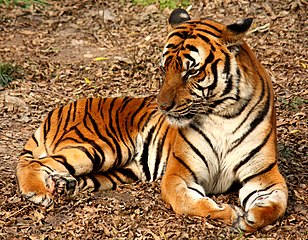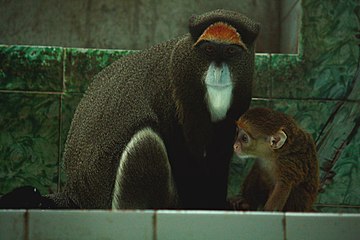Shanghai Zoo
This article has multiple issues. Please help improve it or discuss these issues on the talk page. (Learn how and when to remove these messages)
|
| Shanghai Zoo | |
|---|---|
 The No. 1 ticket booth | |
 | |
| 31°11′44″N 121°21′32″E / 31.195476°N 121.358757°E | |
| Location | No. 2368 Hongqiao Road,[1] Changning District, Shanghai |
| No. of animals | 6,000 |
| Owner | Shanghai Forestry Bureau |
| Website | www |
Shanghai Zoological Park (simplified Chinese: 上海动物园; traditional Chinese: 上海動物園; pinyin: Shànghǎi Dòngwùyuán), or commonly Shanghai Zoo in short, is the one of the two main zoos in Shanghai. It is located near the township of Hongqiao (formerly Hung-Jao) and is administratively in Changning District. Shanghai Zoo was formerly known as " Xijiao Park" (or "Western Suburbs Park") (simplified Chinese: 西郊公园; traditional Chinese: 西郊公園; pinyin: Xījiāo Gōngyuán), which is still a common name used locally for the zoo.
History
[edit]The site of what is presently the Shanghai Zoo was first developed as livery stables in 1890. In 1914, the livery stables were purchased by a consortium of merchants, and in 1916 it was converted into the Hung-Jao Golf Club,[[2] one of Shanghai's largest golf clubs. Like many other foreign-owned clubs, its property was in 1953 resumed by the new government, after the Chinese Communist Party took over Shanghai in 1949. In 1954, the former golf course was opened to the public 1954 as "Xijiao Park". In 1959, a series of animal enclosures were built and the park was expanded. In 1980, the park was renamed "Shanghai Zoological Park".
Current zoo
[edit]After half a century of development, the Shanghai Zoo has become one of the best ecological gardens in Shanghai. The zoo houses and exhibits more than 6,000 animals, among which are 600 Chinese animals that include giant pandas, golden snub-nosed monkeys, lions, South China tigers, hoopoe, black bulbuls, great hornbills and Bactrian camels. Animals from other parts of the world include chimpanzees, giraffes, zebras, kangaroos, gorillas, ring tailed lemurs, common marmosets, spider monkeys, scimitar-horned oryx, african wild dogs, olive baboons, mandrills, Canadian lynxes and maned wolves. The zoo is constantly developing and improving the animal enclosures in order to provide better environments for the animals and a pleasurable experience for visitors.
The original golf course design has been basically preserved. There are a total of 100,000 trees with nearly 600 species planted in the zoo. The green areas and lawns cover an area of 100,000 square meters. The zoo endeavours to create an ecologically friendly environment for the animals - the 'Swan Lake' with its natural reed clumps and trees providing shade for pelicans, geese, black swans, night herons and other birds, is a perfect example of this.
The Shanghai Zoo provides areas for amusement and leisure, opportunities for visitors to increase their knowledge of the various animals and combines this with scientific and technical research to help people better understand and protect animals. Since the zoo was established it has been host to over 150,000,000 visitors.
The aim of the Shanghai Zoo is to have visitors leave with a better understanding of and appreciation for the animals and their environment.
Animals with an asterisk ("*") might have been moved.
- Swan Lake
- Dalmatian pelican
- Great white pelican
- Black swan
- Mute swan
- Bewick's swan
- Whooper swan
- Swan goose
- Mallard
- Common shelduck
- Green-winged teal
- Mandarin duck
- Bar-headed goose
- Greater white-fronted goose
- Bean goose
- Eurasian wigeon
- Ruddy shelduck
- Mandarin duck
- Aviary
- Outdoor Bird Garden
- Pheasant Corridor
- Temminck's tragopans
- Swinhoe's pheasant
- Lady Amherst's pheasant
- Brown eared pheasant
- White eared pheasant
- Great bustard
- Elliot's pheasant
- Big Cat Enclosures
- Outdoor Carnivore Islands
- Carnivore Boardwalk
- Panda House and Bear Pits
- Polar Bear World
- Herbivore Paddocks
- Yak
- Blue sheep
- American bison*
- Blackbuck*
- Red deer
- Sika deer
- Himalayan tahr
- Ibex
- Llama
- Common eland
- Mongolian wild ass
- Sambar
- Scimitar-horned oryx
- wild horse
- Bactrian camel
- Golden takin
- Black muntjac
- Reeve's muntjac
- Red goral
- Hog deer
- Blesbuck
- Giraffe
- Addax*
- Zebra
- Asian elephant
- Lowland anoa*
- Kangaroo Lawn
- Aquatic Mammals Boardwalk
- Spotted seal
- California sea lion
- Fur seals
- Hippo
- South American tapir
- White fallow deer
- Ostrich
- White rhino
- Emu
- Raptor Area
- Golden eagle
- Monk vulture
- Griffon vulture
- Black-eared kite
- Shikra
- Oriental honey-buzzard
- Common kestrel
- American kestrel
- Flamingo Pond
- Waterbird Houses
- Painted stork*
- Yellow-billed stork*
- Brown booby*
- White-breasted waterhen
- Slaty-backed gull
- Black-headed gull
- Herring gull
- Great cormorant
- Scaly-sided merganser
- Grey heron
- Parrot House
- Cockatiels
- Amazon parrots
- Sulphur-crested cockatoos
- Green-winged macaws
- Scarlet macaws
- Blue-and-gold macaws
- Umbrella cockatoos
- Eclectus parrots
- Peach-faced lovebirds
- Salmon-crested cockatoo
- Long-billed corella
- Moustached parakeet
- Hornbill and Toucan Circle
- Wreathed hornbill
- Great hornbill
- Toco toucan
- Red-billed toucan
- Western crowned pigeon
- Oriental pied hornbills
- Wader Stream
- Common crane
- Oriental stork
- Black crowned crane
- Red-crowned crane
- Little egret
- Black-crowned night heron
- White-naped crane
- Chinese pond heron
- Demoiselle crane
- Indoor Bird House
- Black-naped oriole
- Diamond dove
- Red-billed blue magpie
- Black-billed magpie
- Java finch
- Plumbeous water redstart
- Common myna
- Oriental dollarbird
- Bulbuls
- Domestic canary
- Black-capped kingfisher
- Laughing kookaburra
- Penguin Pool
- Bailing Pet World and Small Animal Area
- Dog
- cat
- Binturong*
- Masked palm civet
- Hog badger
- Arctic foxes
- Wild boar
- Cape porcupine
- Eurasian otter
- Coypu
- Raccoon-dog
- Banded mongoose
- Raccoon
- Striped skunk*
- Monkey Houses
- White-headed langur
- Golden snub-nosed monkey
- Stump-tailed macaque
- François' langur
- Olive baboon
- Hamadryas baboon
- Patas monkey
- De Brazza's monkey*
- Ring-tailed lemur
- Weeper capuchin*
- Common squirrel monkey
- Hoolock gibbons
- Ring-tailed lemur
- Spider monkey
- Vervet monkey*
- Crab-eating macaque
- Mandrill
- Black howler*
- L'Hoest's monkey*
- Black-and-white colobus monkeys*
- Lion-tailed macaque*
- Black-and-white ruffed lemur*
- Nocturnal Animal and Tamarin House
- Cotton-topped tamarin
- Common marmoset
- Leschenault's rousette
- Slow loris
- Slender loris
- Sugar glider
- Leadbeater's possum
- Golden-headed lion tamarin
- Ape Islands and Gorilla Pavilion
- Indoor Reptile House
- Asian water monitor
- Green iguana
- King cobra
- Leatherback turtle
- Indian cobra
- Indian python
- Albino Indian python
- Japanese giant salamander
- Bearded dragon
- Radiated tortoise
- Chinese softshell turtle
- Aldabra giant tortoise
- Spectacled caiman
- Chinese stripe-necked turtle
- Chinese pond turtle
- Red-eared slider
- Walk-in Reptile House
- Fresh-and Saltwater Aquarium
- Whitefin sharksucker
- Spadefish
- Moorish idol
- Pennant coralfish
- Threadfin butterflyfish
- Pufferfishes
- Chinese sturgeon
- Bighead carp
- Common carp
- Freshwater angelfish
- Neon tetras
- Blood parrot cichlid
- Giant gourami
- Surgeonfish
- Goldfish Hall and Koi Pond
- Comet goldfish
- Black moor
- Koi
- Lionhead
- Pompom
- Common goldfish
- Bubble eye
- Veiltail
- Shubunkin
- Pearlscale
- Fantail
- Oranda
- Ryukin
- Ranchu
- Celestial eye
- Lionchu
- Children's Zoo
- British Saddleback (pig)
- Sheep
- Goat
Gallery
[edit]-
Model of the zoo
-
Pandas at the zoo
-
Gorilla enclosure
-
Peacock
-
Wolf enclosure
-
Brown Bear pit
-
Elephant enclosure
-
Giraffe enclosure
-
Lemur
-
Fish tank
-
Monkey
-
Small monkeys
-
South China Tiger
-
Sun bear
-
Camel
-
Red Panda
-
Great Pied Hornbill
-
Black Naped Oriole
-
Golden takin
-
Addax
-
Chinese alligators
-
Black Muntjac
-
De Brazza's monkey
-
Golden snub-nosed monkey
References
[edit]- ^ 我们的历史 (in Simplified Chinese). Shanghai Zoo. Retrieved February 26, 2014.
上海市虹桥路2381号
- ^ Washburn, Dan (2016-07-18). The Forbidden Game: Golf and the Chinese Dream. Oneworld Publications. ISBN 978-1-78607-020-3.
























